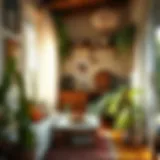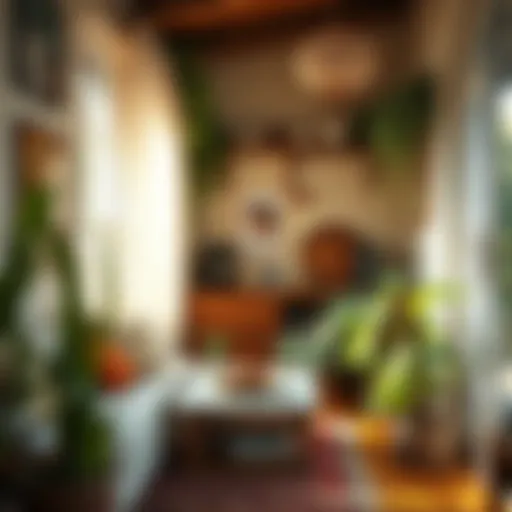Exploring the Impact of Wall Sconce Fly Light Traps
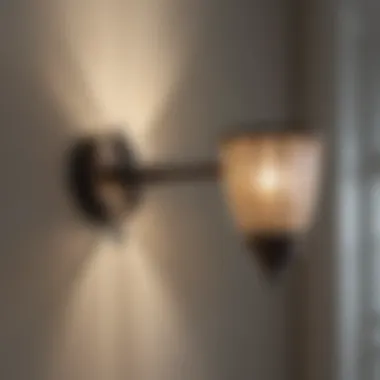

Intro
This article explores the inner workings of these traps, their effectiveness, and how they compare to traditional pest control methods. We will examine pest identification, prevention methods, and DIY solutions that complement the use of wall sconce traps. In doing so, we aim to equip house owners and housewives with knowledge and tools necessary to create a pest-free living space.
Pest Identification
Common Household Pests
Flies represent one of the most common household pests that many encounter. The housefly, for instance, is prevalent in urban areas, often attracted to food and waste. Other pests that may be found indoors include fruit flies, which are drawn to ripened fruits and vegetables, and drain flies, which thrive in damp environments near sinks and drains.
Signs of Infestation
Identifying an infestation early can significantly aid in managing it. Some common signs of fly infestations include:
- Frequent sightings of flies, particularly around food sources.
- Breeding sites found in areas with standing water or decaying organic matter.
- Unpleasant smells emanating from clogged drains or trash bins.
Awareness of these signs enables homeowners to detect issues before they escalate and consider appropriate interventions, including employing wall sconce fly light traps.
Prevention Methods
Environmental Modifications
Preventing infestations is always preferable to dealing with an established problem. Implementing environmental modifications can minimize the likelihood of attracting pests. Some strategies include:
- Keeping food sealed and stored properly.
- Cleaning surfaces to remove any food residue.
- Regularly disposing of waste and ensuring trash bins are tightly covered.
Home Maintenance Tips
Routine home maintenance is essential in thwarting pest entry and reproduction. Actions such as:
- Sealing small gaps and cracks in windows and doors can block entry points for flies.
- Repairing any plumbing leaks reduces the moisture that can attract pests like drain flies.
- Regularly checking and maintaining outdoor areas, ensuring no standing water is present.
All these efforts create an environment less hospitable to flies and similar pests.
DIY Pest Control Solutions
Natural Remedies
For those preferring a non-toxic approach, various natural remedies can assist in managing flies. Some popular methods include:
- Vinegar traps, where vinegar is placed in a bowl covered with plastic wrap, allowing flies to enter but not exit.
- Essential oils like peppermint or eucalyptus that can deter flies when diffused in spaces known to have infestations.
DIY Traps and Barriers
In addition to natural remedies, creating DIY traps and barriers can enhance pest control. Simple strategies include:
- Using sticky tapes hung in areas with high fly activity to trap them actively.
- Setting up homemade barriers using fabric or netting to cover food and other attractants.
Incorporating these DIY methods with the use of wall sconce fly light traps can lead to significant improvements in managing pest populations, ultimately contributing to a more comfortable living environment.
"Understanding the mechanics and implementing effective pest management strategies can significantly reduce household infestations, ensuring a healthier home."
This article aims to provide you with comprehensive insights into the effectiveness of wall sconce fly light traps and how they can be integrated with other methods to achieve optimal pest management.
Understanding Wall Sconce Fly Light Traps
Wall sconce fly light traps present a unique and effective solution for dealing with flying pests like flies and mosquitoes. Understanding these devices is crucial for homeowners and housewives who prioritize maintaining a healthy living environment. These traps integrate light technology to lure insects, using minimal space while offering greater convenience.
Definition and Purpose
Wall sconce fly light traps are specialized devices designed to capture flying insects. They often feature an enclosed housing with a light source that attracts flies. Once the insects are drawn close, they can be trapped using various methods, such as adhesive surfaces or electrocution grids. The primary purpose of these devices is to reduce insect populations indoors, thus enhancing comfort and hygiene.
Historical Development
The development of light-based insect traps dates back several decades. The initial designs mostly relied on traditional light bulbs and simple trapping mechanisms. Over time, advancements in technology led to the introduction of more efficient designs. Manufacturers began utilizing LED lights and better materials. This evolution improved the traps' effectiveness and energy efficiency.
The combination of improved lighting systems and innovative trapping methods has made wall sconce fly light traps a popular choice in pest control today. Their increasing utility in both residential and commercial spaces highlights the need for ongoing understanding of their design and operational aspects.
Technical Composition
Understanding the technical composition of wall sconce fly light traps is crucial. This section examines the materials and lighting mechanisms that make these devices effective in pest management. The right combination of materials and technology not only enhances performance but also determines durability, reliability, and user satisfaction. Exploring these elements provides insight into how each component contributes to the overall effectiveness of these systems.
Materials Used
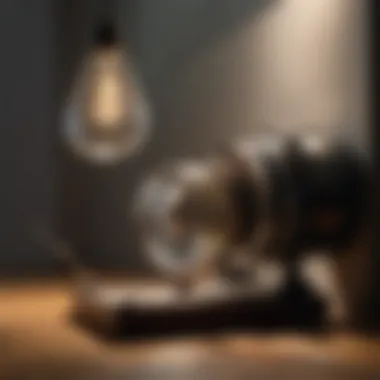

Plastic Components
Plastic components are fundamental in the construction of wall sconce fly light traps. They offer lightweight properties, making installation easier and adaptable to various settings. One key characteristic of plastic is its resistance to corrosion, which is beneficial for outdoor applications. Additionally, plastics can be molded into complex shapes, allowing for innovative designs that fit aesthetic and functional needs. However, a notable downside is that some plastics can degrade over time, especially under prolonged exposure to UV light. Manufacturers must select high-quality plastics that mitigate these weaknesses.
Metal Housing
Metal housing is another vital aspect of wall sconce fly light traps. It provides strength and stability, securing internal components against impacts. The main benefit of metal is its durability. Unlike plastic, metal does not crack or break easily, enhancing the lifespan of the unit. Furthermore, metal can help dissipate heat generated by bulbs, improving performance. A challenge, however, is the potential for rust if not properly coated. Using rust-resistant metals like aluminum or stainless steel can address this issue, ensuring longevity in various environmental conditions.
Glass Elements
Glass elements play a key role in the functionality of wall sconce fly light traps. They often serve as protective coverings for light sources, which enhances safety while maintaining aesthetic appeal. The key characteristic of glass is its clarity, allowing maximum light penetration, which is crucial for attracting flies. Another advantage is that glass does not degrade like plastic when exposed to UV light. However, glass is heavier and more fragile than other materials, making it a less favorable choice in some instances. Care must be taken during installation to prevent breakage.
Lighting Mechanisms
LED Technology
LED technology is at the forefront of lighting mechanisms in wall sconce fly light traps. The low energy consumption of LEDs makes them a popular choice, as they reduce electricity costs. Another significant aspect is their long lifespan, often lasting thousands of hours. This technology also produces less heat compared to incandescent bulbs, minimizing fire hazards. However, the initial cost of LED fixtures can be higher than traditional options, which may deter some consumers.
Fluorescent Bulbs
Fluorescent bulbs provide a cost-effective alternative in the lighting mechanisms of these traps. They offer a higher output of light compared to incandescent options, efficiently attracting flies. One key benefit is their affordability and wide availability, making them an accessible choice for many users. However, fluorescent bulbs have a shorter lifespan than LED technology and are less energy-efficient, which could lead to higher long-term costs.
UV Light
The use of UV light is critical for effective fly attraction in wall sconce traps. UV light specifically targets behaviors in insects that draw them toward the light, enhancing trapping efficiency. A primary advantage of UV light is its ability to lure a wider range of pests. However, users should be aware of the potential drawbacks, such as the need for regular bulb replacements and the fact that UV light can be harmful to eyes and skin upon direct exposure. Care should be taken to position these devices safely.
"Understanding the materials and mechanisms is essential for optimizing wall sconce fly light traps for both efficiency and user safety."
Operational Mechanism
Understanding the operational mechanism of wall sconce fly light traps is crucial in grasping their effectiveness in pest control. This section highlights how the interaction of various components, such as light sources and trapping mechanisms, creates an efficient system for attracting and capturing flies. More than just a matter of convenience, the proper functioning of these traps enhances their reliability in managing pest populations indoor and outdoor settings. The choice of light, trapping methods, and their integration are essential considerations for homeowners seeking effective pest management solutions.
How Light Attracts Flies
Light plays a pivotal role in attracting flies toward wall sconce light traps. Specific wavelengths and intensities of light can significantly influence fly behavior. Flies are particularly drawn to ultraviolet (UV) light because they see it better than humans do. Many fly species associate bright lights with food sources or habitable areas, making them more vulnerable to capture. Understanding this behavior allows users to strategically choose the right light source in their traps, leading to a higher catch rate.
Trapping Mechanisms
The trapping mechanisms used in wall sconce fly light traps vary, each with unique features that contribute to their effectiveness. The three main types are adhesive plates, electrocution grids, and vacuum systems. Each method appeals to different user preferences for efficiency, cleanliness, and ease of use.
Adhesive Plates
Adhesive plates have become a popular choice in fly traps due to their simplicity and effectiveness. These plates utilize a sticky surface to ensnare flies once they are drawn in by the light. The key characteristic of adhesive plates is their passive trapping method, requiring no electrical components. This is a distinct advantage for households seeking a safe and relatively maintenance-free solution.
However, adhesive plates do have some disadvantages. They may need frequent replacement, especially during peak fly seasons. Furthermore, after capturing the flies, the trapped specimens remain visible, which some people may find unappealing.
Electrocution Grids
Electrocution grids represent a more active approach to trapping flies. When attracted to the light, flies make contact with the electrified grids and are quickly neutralized. The key characteristic of these grids is their immediate classification as a lethal pest control option, often leading to a swift reduction in fly populations.
Electrocution grids have various advantages, including the speed of kill and reduced maintenance. They eliminate the need for continuous plate replacements. However, they can pose certain risks, particularly in households with children or pets. Safety features are often required to mitigate these concerns, as stray contacts could result in unintended consequences.
Vacuum Systems
Vacuum systems provide a unique alternative for capturing flies in wall sconce traps. These systems utilize suction to draw the flies into a collection container. The key characteristic of vacuum systems is their non-lethal approach, allowing for the release of captured flies if desired. This method is beneficial for eco-conscious users.
A significant advantage of vacuum systems is their ability to capture a larger number of flies without direct contact, making them a cleaner choice. However, they might require a more complex installation and regular cleaning of the collection canister, which can discourage some users. Understanding these aspects is crucial to charge a household’s approach to long-term pest management through wall sconce fly light traps.
Effectiveness and Efficiency
Understanding the effectiveness and efficiency of wall sconce fly light traps is crucial for their optimal use in pest management. These devices are not merely decorative elements; they serve a practical function by addressing fly infestations effectively. When evaluating their utility, one must consider various factors that influence their performance, including the type of light source, placement, and the surrounding environmental conditions. All these aspects contribute to the overall success of the unit in both attracting and trapping flies.
Factors Influencing Efficiency
Type of Light Source
The type of light source used in wall sconce fly light traps significantly impacts their overall effectiveness. LED lights, for instance, are notable for their energy efficiency and longevity. This makes them a beneficial choice as they provide a sustained source of illumination without excessive power consumption. Moreover, the spectrum of light emitted by LEDs can be tailored to attract a specific range of flying insects. However, there is a consideration where certain types of light might not be as effective against all species.
Another option is fluorescent bulbs, which have historically been used in various pest control settings. The key characteristic of these bulbs is their ability to emit UV light, which is particularly attractive to many insects. Despite their utility, fluorescent bulbs are less energy-efficient than LEDs, leading to higher operational costs in the long term. Thus, understanding these nuances can help users make informed choices about the light types they select for their traps.
Placement and Positioning
Placement and positioning of the wall sconce are essential for maximizing efficiency in fly trapping. The ideal scenario involves mounting the sconce at a height that aligns with typical flying insect pathways. A key characteristic of effective positioning is ensuring that the light is unobstructed by furniture or wall decor. Furthermore, placing the device near common fly entry points or areas susceptible to infestations greatly enhances its effectiveness.
While high walls may provide a clean aesthetic, this can hinder the trap's efficiency if flies are at lower altitudes. Therefore, finding a suitable balance is crucial. Improper placement can result in diminished attraction, leaving certain areas vulnerable to infestations.
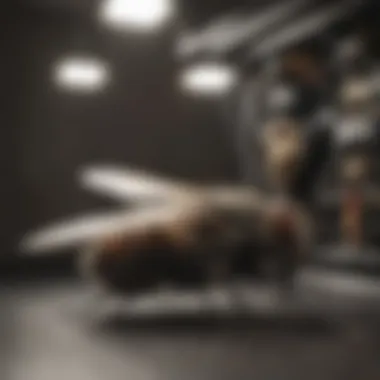

Environmental Conditions
Environmental conditions play a vital role in the operation of wall sconce fly light traps. Variables such as humidity, temperature, and overall cleanliness can influence the success of these devices. For instance, high humidity may intensify insect activity, thereby affecting the trap's performance. The key characteristic of favorable conditions is a clean and dry environment where flies are commonly present.
Furthermore, environmental factors like competing light sources can detract from the effectiveness of the trap. Bright outdoor lights or indoor fixtures may distract flies, leading them to avoid the trap entirely. Understanding these environmental dynamics aids in optimizing the trap's installation and usage to achieve the best results.
Comparative Efficiency Studies
Studies examining the comparative efficiency of wall sconce fly light traps versus other pest control methods reveal insightful data. Such comparisons often cover elements like trapping rates, user satisfaction, and long-term sustainability.
Some research indicates that traps utilizing UV light demonstrate superior performance compared to traditional insect-repellent methods, while others highlight the benefits of integrated pest management strategies involving these traps alongside biological pest control. These studies contribute to the understanding of optimal practices in using wall sconce traps, guiding users towards more effective pest management solutions.
Environmental Considerations
The significance of environmental considerations in the context of wall sconce fly light traps cannot be overstated. These devices are intended not only for pest control but also for minimizing adverse impacts on ecological systems. Understanding how these traps align with eco-friendly objectives is vital for sustainable pest management strategies. Careful examination of their composition, operation, and influence on surrounding ecosystems reveals important insights.
Eco-Friendliness
Eco-friendliness signifies the device's capacity to function without causing significant harm to the environment. Wall sconce fly light traps are engineered primarily with this principle in mind. Many models rely on energy-efficient lighting solutions such as LEDs. The use of LED technology substantially reduces energy consumption compared to traditional light sources. As a result, this not only lessens environmental impact but also lowers user electricity costs. Additionally, the materials used in the construction of these traps often feature recycled components, which further enhances their eco-friendly profile.
Moreover, the absence of chemical pesticides in these devices makes them a safer option for households, particularly those with children and pets. By employing light-based attraction methods, these traps mitigate the potential risks ordinarily associated with chemical treatments.
Impact on Non-Target Species
Research Findings
Research findings indicate that while wall sconce fly light traps excel at targeting specific pest species, they can also inadvertently affect non-target insects. Studies highlight that certain light wavelengths may attract beneficial insects, such as pollinators. This characteristic can have unintentional ecological consequences. Thus, the design of light traps must strike a balance between effectiveness in pest management and preserving useful insect populations. A beneficial aspect of continuous research in this area is the ability to make design improvements that limit such impacts. Innovations may involve using selective wavelengths that attract fewer non-target species, ensuring a more responsible approach to pest management.
Mitigation Strategies
To address the concerns surrounding the impact on non-target species, mitigation strategies play a crucial role. These often include refinements in design to diminish attraction to non-target insects. Employing specific light wavelengths that primarily attract pests can significantly reduce unintended captures. Another strategy involves positioning the traps strategically to deter non-target species from approaching.
Furthermore, ongoing research offers the possibility of improved materials and technologies that minimize unwanted catches without compromising effectiveness against targeted pests. With these approaches, homeowners can adopt pest management practices that are both effective and considerate of the broader ecosystem.
"Environmental considerations are important not just for public safety but for the preservation of our ecological systems."
In summary, focusing on eco-friendliness and the impact on non-target species is essential for the effective utilization of wall sconce fly light traps. Understanding these factors not only enhances the traps’ utility but also cultivates responsible and sustainable practices in pest management.
User Guidelines
User guidelines play a crucial role in ensuring the proper usage and longevity of wall sconce fly light traps. Understanding the installation, maintenance, and operational procedures guarantees that these devices function efficiently. Observing these guidelines can significantly enhance the overall effectiveness of fly control measures, promoting a pest-free environment.
Installation Recommendations
When installing a wall sconce fly light trap, proper placement is key. The device should be positioned in areas where flies are commonly observed. This is usually near entry points such as doors or windows. Additionally, it is vital to keep the device away from direct sunlight, as this can reduce its visibility to flies.
Mounting height is another critical aspect. The ideal height is typically around eye-level to maximize visibility and attraction. Ensuring that the sconce is securely fixed will also prevent accidents. Moreover, each unit should have adequate space around it for effective airflow and light dispersion.
Maintenance Practices
Cleaning Procedures
Regular cleaning is an essential part of maintenance for wall sconce fly light traps. Accumulation of dirt and debris can hinder the effectiveness of these devices. It is advisable to clean the exterior of the unit with a damp cloth. This simple procedure helps to keep the light bright and visible.
Another important aspect is the inspection and cleaning of internal components, especially the trapping mechanism. If sticky adhesive plates are used, replacing or cleaning them frequently ensures the unit captures flies effectively.
Bulb Replacement
Replacing the bulbs at regular intervals ensures that the trap maintains optimal performance. Depending on the bulb type, LED or fluorescent, replacement frequency may vary. LED bulbs are known for their longevity, but eventual replacement is still necessary.
When changing bulbs, it is crucial to follow manufacturer instructions to ensure safety and device integrity. Using the right wattage and type of bulb ensures the device attracts flies effectively. A well-maintained bulb system contributes directly to the overall efficiency of the fly trap.
Seasonal Adjustments
Seasonal adjustments should be considered to enhance the trap's effectiveness throughout the year. Different seasons may influence fly behavior and population. For instance, managing light intensity during the colder months can conserve energy while still providing adequate attraction.
Additionally, it may require repositioning depending on the season. For instance, in summer, when flies are more prevalent, ensuring the lights are operational and at peak attraction can help reduce their numbers significantly. Regular assessment of seasonal changes ensures that trapping remains effective year-round.
"A well-maintained wall sconce fly light trap is not just an asset; it is a necessity for any effective pest management strategy."
Understanding and adhering to these user guidelines will empower homeowners and housewives to maintain an efficient fly control system, assuring a comfortable living environment.
Market Analysis
The analysis of the market for wall sconce fly light traps is crucial for several reasons. It sheds light on consumer behavior, trends in pest control, and the overall effectiveness of these devices in various environments. Understanding this market can help manufacturers tailor their products to meet consumer expectations while also addressing the challenges posed by pests in residential and commercial settings.
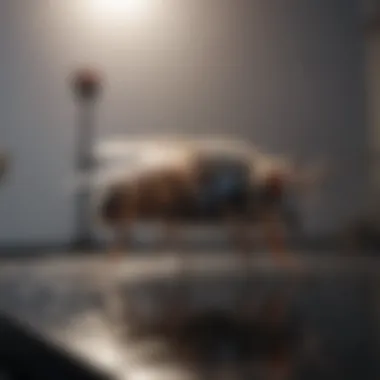

In recent years, there has been an increasing awareness of the need for effective pest management solutions. House owners and housewives are increasingly interested in products that provide durability, efficiency, and ease of use. The market for wall sconce fly light traps is influenced by factors such as environmental concerns and the rising popularity of eco-friendly pest control options. This promotion of greener alternatives shapes consumer preferences.
Consumer Preferences
Consumers gravitate toward wall sconce fly light traps that blend functionality with aesthetics. Many seek designs that complement their home decor while ensuring effective pest control. Features like energy efficiency and low maintenance are also significant deciding factors. Buyers appreciate when manufacturers incorporate LED technology, as it offers both longevity and reduced power consumption. Moreover, compliance with health and safety standards will play a vital role in attracting more customers.
In summary, consumer preferences are shaped by several aspects:
- Design and aesthetic appeal
- Energy efficiency
- Maintenance requirements
- Safety standards compliance
- Eco-friendliness of the product
Price Comparison
When evaluating wall sconce fly light traps, price comparison is essential. Different brands offer variable pricing structures based on technology, build quality, and features. For instance, high-end models that utilize advanced UV light technology or are integrated into smart home systems typically demand a higher price. In contrast, basic models may be more budget-friendly but may not offer the same level of effectiveness or durability.
The range of prices can be categorized as follows:
- Budget-friendly options: These models may cost between $30 to $60, ideal for individual household use.
- Mid-range models: Price varies from $60 to $100, providing enhanced features such as added safety measures or more effective trapping mechanisms.
- Premium models: Prices can exceed $100, reflecting advanced technology, longevity, and design elements.
Understanding these price ranges can help consumers make informed decisions based on their needs and budget. The cost-benefit analysis of investing in a wall sconce fly light trap highlights how a higher initial investment may lead to better long-term outcomes in pest management.
"By comprehending the nuances of the market, consumers can make choices that align with their values and budget, fostering a more educated approach to pest control products."
Ultimately, a thorough market analysis empowers consumers, enabling them to select wall sconce fly light traps that align with their home management strategies.
Technological Advancements
The role of technological advancements in wall sconce fly light traps is significant, influencing user experience, effectiveness, and adaptability. Modern inventions in this field emphasize efficacy in pest management while ensuring convenience and environmental sustainability. With constant advancements, homeowners and housewives benefit from innovative solutions that meet their specific needs.
Emerging Technologies
Recent innovations have transformed the design and functionality of wall sconce fly light traps. Notable among these are:
- Smart Sensors: These allow for automatic operation, activating the trap when flies are detected. This ensures optimal power consumption and reduces unnecessary light usage when flies are absent.
- Advanced UV Light Sources: Improved UV technology now promises stronger attraction capabilities. Devices use specific wavelengths that are most appealing to flying insects, ensuring a higher capture rate.
- Biological Deterrents: Some modern designs incorporate substances that safely repel insects, reducing fly populations before they reach the light sources.
These technologies enhance user satisfaction by providing more effective, efficient, and eco-friendly pest control solutions.
Integration with Smart Home Systems
Integrating wall sconce fly light traps with smart home systems represents a significant trend that offers convenience and functionality. Homeowners can remotely control these devices through mobile applications, allowing for:
- Real-Time Monitoring: Individuals can receive notifications about trap activity, enabling them to take timely actions.
- Schedule Settings: Users can set their traps to operate during specific times, aligning their pest control measures with their home routines. This feature can conserve energy and prolong the life of the lighting components.
- Data Insights: Some smart systems may provide analytics on pest activity, helping users make informed decisions about their pest management strategies.
Incorporating these systems not only enhances the experience but also contributes to a more efficient home environment. Thus, the advancement of wall sconce fly light traps goes beyond mere pest control, turning them into integral parts of modern living.
"Technological advancements turn everyday household challenges into manageable tasks through innovation."
By adopting these new technologies, homeowners can enhance their defenses against pests while promoting a sustainable and efficient living space.
Regulatory Considerations
Understanding regulatory considerations is crucial for anyone interested in wall sconce fly light traps. As the demand for effective pest control solutions increases, it becomes necessary to conform to established regulations. These standards not only ensure the product's effectiveness but also safeguard the health of users and the environment. Non-compliance can lead to repercussions ranging from fines to product recalls, which can affect consumer trust.
Health and Safety Standards
Health and safety standards play a pivotal role in the design and functionality of wall sconce fly light traps. These guidelines are established by various health and safety organizations to minimize risks to users. Devices must be made from non-toxic materials to prevent harm in residential environments, especially where children and pets are present. The standards also dictate electrical safety protocols. This includes ensuring the traps are resistant to moisture, protecting against electrical hazards. Users should look for certifications from recognized bodies. This gives assurance that the product meets necessary safety benchmarks.
"Adhering to health and safety standards is not just a legal requirement; it's essential for maintaining user confidence and safety."
Environmental Regulations
Environmental regulations are equally significant when considering wall sconce fly light traps. These regulations aim to protect ecosystems from harmful substances and practices. For example, traps must not emit excessive pollutants that can affect air quality or lead to chemical run-off in surrounding areas. Manufacturers are expected to disclose information regarding product disposal and the potential environmental impacts of their devices.
Purchasing traps that comply with environmental standards can contribute to a more sustainable pest control approach. Additionally, eco-friendly designs using renewable or recycled materials can enhance marketability and appeal to a growing demographic concerned about environmental impact.
In summary, the regulatory landscape surrounding wall sconce fly light traps encompasses both health and safety measures, alongside rigorous environmental regulations. This dual focus serves to ensure that these devices are safe for personal use, while also protecting the wider ecosystem. Being informed about these considerations enhances consumer knowledge, guiding better purchasing decisions.
Future Directions
The exploration of future directions in the context of wall sconce fly light traps is crucial for advancing both technology and user satisfaction. With growing public concern about pest management and environmental impact, improvements in efficiency are necessary. The future potential of these devices lies primarily in their integration with emerging technologies and innovations in design.
Predicted Trends
Several trends are anticipated to influence the future development of wall sconce fly light traps:
- Smart Technology Integration: With the increasing popularity of smart home systems, wall sconce fly light traps may increasingly adopt connectivity features. This would allow homeowners to control and monitor devices remotely via smartphones or voice-controlled assistants like Amazon Alexa or Google Home.
- Increase in Energy Efficiency: The push for sustainable solutions might propel manufacturers to develop more energy-efficient models. Innovations in LED technology could reduce power consumption while improving performance, appealing to environmentally conscious consumers.
- Enhanced Aesthetic Designs: There may be a shift towards more aesthetically pleasing designs that blend seamlessly into home decor. As homeowners seek out functional yet attractive solutions, manufacturers might focus on customizable options to meet personal styles.
Potential Research Areas
The scope of research related to wall sconce fly light traps can be expansive, touching on several important aspects:
- Behavioral Studies on Insect Attraction: Further research can be conducted into insect behavioral patterns to improve trapping mechanisms. Understanding how light and scent influence insect attraction can result in more effective traps.
- Material Science Innovations: As technology progresses, new materials that enhance durability and efficacy could emerge. Research into synthetic materials that are more challenging for pests to escape from might yield significant advancements.
- Sustainability Assessments: Evaluating the environmental impact of different design choices is essential. Studies focusing on the lifecycle of these products, from production to disposal, will inform more sustainable practices.
- Integration of Trapping Devices with Smart Ecosystems: Investigating how these devices could interact with existing smart home technologies could uncover new uses and applications, maximizing their effectiveness and convenience.
Continuous advancements in technology have the potential to revolutionize pest management, making wall sconce fly light traps more effective and user-friendly.








